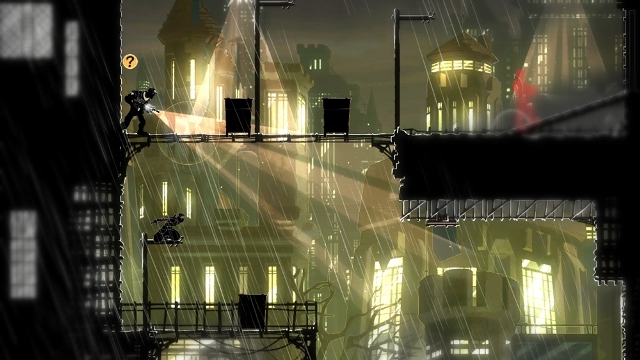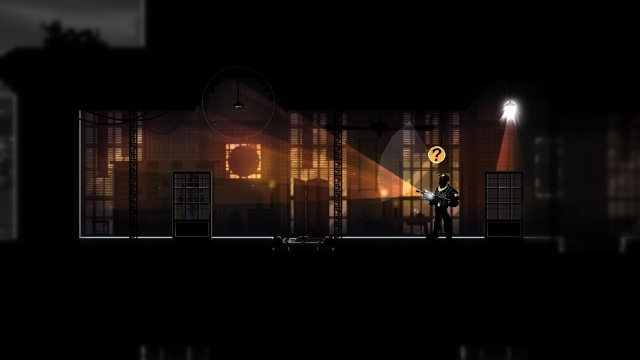Mind of the Ninja
When Konami’s legendary game designer Hideo Kojima shows up to discuss what he’s been up to and then proceeds to show it to the world for the first time, it tends to expose the fact that the event he’s showing it at has become a bit of a big deal. There was no need for Kojima’s traditionally obligatory exclamation points to suddenly appear over the heads of the PAX Prime enforcers to make that much clear. The Big Stealth Game, Metal Ground Solid: Ground Zeroes, was revealed on the big stage to the delight of seemingly everyone watching.
Not all eyes were glued on Kojima, however; back on the show floor PAX’s little stealth game was leaving everyone who found their way to Klei Entertainment’s little corner in the not-so-little Indie Megabooth equally impressed. The XBLA Fans team had previously gotten our hands on Mark of the Ninja back at PAX East, but that didn’t make us any less eager to take it for another spin or to speak with its lead designer, Nels Anderson.
On Friday the game will release on XBLA. Long before getting to that point, however, the studio had to commit to setting out in a completely different direction than it did with its previous work on the Shank franchise. Doing so meant forging a mostly new path, since very few 2D stealth-oriented games had come along over the years to lay down the groundwork. I asked Anderson if that meant Klei had some unique challenges to overcome while developing the game. Laughing, he rhetorically replied, “Um, all of them?”
“All of them, in fact!” the designer exclaimed, now seemingly convinced that it was in fact all of the systems that presented challenges. “Because no one’s ever really done one, right? Like there were a couple very, very small ones, but certainly nothing to this scope or magnitude — at all. So then it’s like, we just sort of had to like really look at 3D stealth games and sort of reconstruct them design-wise. Like, ‘Why did they make the kinds of decisions they made?’ And then take that up a level and translate it back down to 2D.
“I mean, there aren’t templates or schemes to drop in in this context — at all. Which is good, it just means we had to try a whole lot of stuff that didn’t work before we got to stuff that actually did work.”
If Mark of the Ninja‘s first level is anything to go by, then the indie developer certainly found something that works. Players take control of a ninja whose clan has been attacked by assault-rifle wielding intruders. It’s a natural setup for a ninja to do what ninjas do best: sneak among the shadows. Of course, gamers can elect to run right up to a bad guy and spam the X button in an attempt to take him out, but it’s not recommended. The game’s adversaries really know how to take a beating before keeling over, and they’re more than happy to alert other nearby guards should you reveal yourself to them.
Enemies going on alert and conducting a thorough search until a timer runs out conjures up memories of a neverending flood of guards that always seem to know exactly where they should look in some other games. So is that how things work in Mark of the Ninja? Do packs of guards perpetually and mysteriously appear out of nowhere every time a single one is alerted to the ninja’s presence? Not quite. Anderson quickly and emphatically dismissed the idea. “Nooooo! We did try that at one point,” he explained, “where it was like, enemies would be spawned procedurally in response to an alarm, and it just didn’t work. So it’s like, there are enemies in an environment, and when it goes off it’s a radius, and guys may or may not hear it. But it’s just the guys on the level and that’s it. There aren’t any magical men from nowhere.”
A lack of “magical men from nowhere,” as previously mentioned, does not mean that players can blaze across the screen, carelessly approaching bad guys head-on and leaving a trail of bodies in their wake, though. There is some wiggle room in the area of play style, but approaching confrontations as if they were still in control of the protagonist from Klei’s last XBLA game isn’t going to work out. The ninja’s best weapons aren’t blades, but darkness and diversions. Anderson explained that, “regardless of what you want to do, you have to be sneaky. It’s how you apply being sneaky that the player choice comes in. If you’re going to kill a whole bunch of dudes, that’s cool. You’re totally welcome to do that. But you’re still going to have to be sneaky to do that. You can’t ever just run straight in, guns bla—because you’re just going to get ruined. You gotta be sneaky regardless, so we make all that kind of stealth stuff really…transparent and really easy to get at. So then, it’s just how you want to apply [that] is really at the player’s discretion.”
In the game, players can peak into rooms to get the lay of the land before deciding which of multiple entrances is the best way in. Once inside, they can then toss darts to set off gongs are shatter lights, thus directing an enemy’s attention to a specific location. This sets up the perfect opportunity to sidle up and gruesomely slit the guard’s throat, if that’s your thing. Conversely, the area can be bypassed entirely without any bloodshed. “You can get through the entire game without killing anybody, Anderson revealed. “It’s not easy, don’t get me wrong. But it is certainly possible.”
The system works incredibly well; it’s genuinely fun to remain as stealthy as possible while playing. I was curious how it translated over to boss fights, though. The answer is that it doesn’t, or rather, that the team decided that it would not have. Anderson told me that “there’s nothing supernatural in the game, right? All the antagonists are just people. So having all the sudden, ‘oh, here’s some giant magical guy with some huge health bar,’ it’s like, it doesn’t really make any sense. There are certainly characters that are antagonists, and you dispatch them, but it’s through more of a like ‘set-piece encounter,’ I guess. As opposed to, ‘Here’s a guy with a health bar.’ As we’ve seen in some recent games, boss fights in stealth games tend not to work very well.”
Many indie developers throw everything they can think of at the proverbial wall in an attempt to get as much crazy crap into their game as they can. Though that approach worked quite well for a number of devs in the Indie Megabooth, Klei shied away from it when making Mark of the Ninja. The studio was careful to only work in elements that meshed with each other. It wanted to create an experience that felt cohesive from beginning to end, so anything that seemed out of place was left on the cutting room floor. Along the way, the team realized that the stealth genre it loved had some room for improvement.
“It wasn’t like a gigantic goal from the outset necessarily,” Anderson said of improving on genre staples that he perceived as broken. “But just through the course of building the thing one of the things we noticed is — like, I like stealth games a lot, but I get why they can be kind of inaccessible for folks, because a lot of those core stealth systems tend to be very opaque, right? Where it’s like, you know, ‘There’s a guy up ahead. If I make a noise, is he gonna hear me? I guess I gotta just try and…oh look, he did.’ And then you get shot or stabbed in the face, and — tears. It’s like, well, let’s not, let’s not do that. Let’s just make all that stuff very explicit so you understand straight out [of] the gate what’s going on with the game’s stealth system. So it’s just another ‘tool’ in your arsenal, so to speak, that you can use to manipulate the enemies and objects in the environment and all that stuff — and get what you want.”
What about Anderson? Did he get what he wanted out of the experience of developing Mark of the Ninja? “I’ve always really liked stealth games. So being able to actually design one was awesome. Yeah.”




